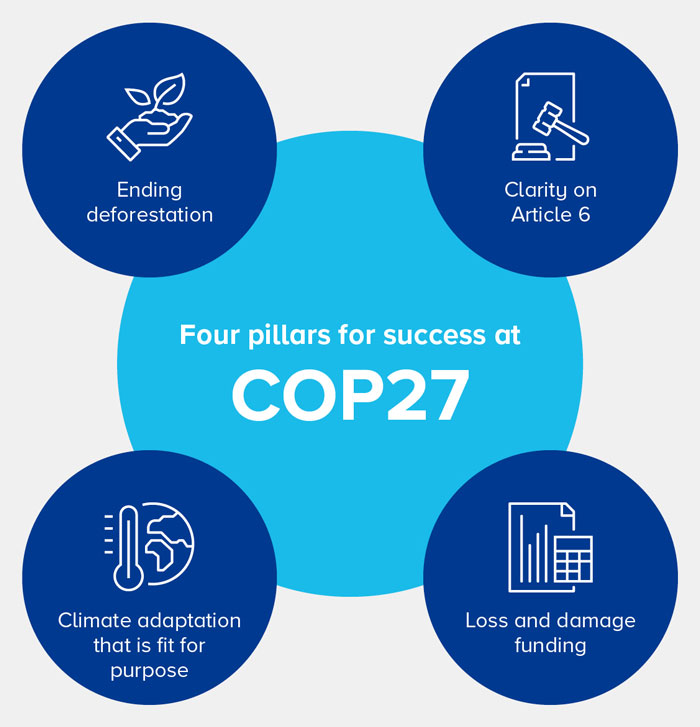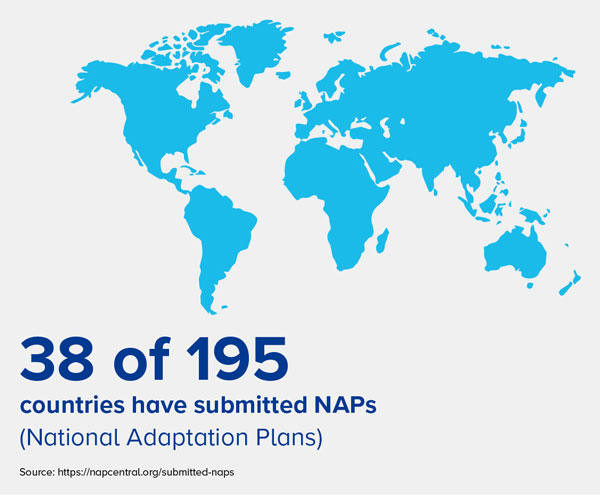Four key outcomes that COP27 needs to achieve
October 24, 2022The 2021 United Nations Climate Change Conference (COP26) ended with some seemingly impressive headlines on financing, coal, and deforestation but failed to provide the tangible ambition necessary to avoid the worst impacts of climate change.
We need COP27 to plug the gap and go further – especially when it comes to accountability, climate adaptation, loss and damage, clarity for the carbon markets, and operationalising Article 6.
What is on the agenda at COP27?
COP27 will be held in Sharm el-Sheikh, Egypt from 6 to 18 November 2022—the fifth COP to be hosted in Africa.
Each day at COP27 will centre around a theme: these include finance, science, youth and future generations, decarbonisation, adaptation and agriculture, gender, water, biodiversity, and solutions. Of particular interest to business, the decarbonisation day will include deep dives into hard-to-abate sectors such as steel, cement, and fertilisers, as well as a discussion on the global methane pledge that was signed by 122 countries at COP26.
As highlighted by WWF, this COP has a unique opportunity to consider the specific needs and circumstances of Africa as a whole: “All discussions at COP27 should take into account and benefit from the insights, expertise, and capacities that have been developed in Africa in addressing the challenges posed by climate change.” It is great to see the agenda hold the promise of this.
Despite the fragile and divided nature of recent geopolitics – notably due to Covid, rising inflation, fears of economic recessions, and the war in Ukraine – ClimatePartner remains cautiously hopeful that COP27 will instil a sense of unity and collaboration in our shared fight against climate change.

1. Ending deforestation
At COP26, the Glasgow Forest Declaration to “halt and reverse forest loss and land degradation by 2030” convinced 141 signatories, who are responsible for an impressive 91% of global forest cover.
Despite this international commitment, deforestation rates of primary tropical forests have yet to decrease. Satellite data showed 3.75 million hectares of tree cover, or 10 football pitches a minute, disappeared across primary tropical forests in 2021, with initial reports matching that pace.
This highlights the importance of companies investing in reducing emissions from deforestation and forest degradation projects (REDD+). ClimatePartner is seeing exciting movements in the space of jurisdictional REDD+, a type of integrated landscape and forest protection with high levels of government involvement, leading to comprehensive governance of land use across entire political territories. Jurisdictional REDD+ holds the promise to provide greater environmental integrity to forest protection, for instance by reducing the risk of leakage within political borders.
For the time being, there is still a lack of clarity on how project-based REDD+ credits will be traded, and ClimatePartner is not expecting interest in or availability of these credits to diminish, given the great importance of forest protection for climate mitigation. We simply must act to protect forests today.
2. Clarity on Article 6
ClimatePartner would like to see agreement on all elements necessary to fully operationalise Article 6 with environmental integrity and to generate financing for a just transition to societal net zero.
At COP26, we saw lots of conversation around Corresponding Adjustments (CAs). A CA is the mechanism of adjusting the national greenhouse gas (GHG) emissions inventory of a project's host country when carbon credits are sold. For example, if a carbon offset project in Brazil were to sell carbon credits, Brazil would not be able to use these emission reductions to achieve its own climate target, as these would be counted in the purchasing country’s GHG emissions inventory.
There is currently no standardised way for host countries to issue CAs, leaving many countries unprepared. A standardised approach would support countries in taking the steps necessary to enter into bilateral agreements and therefore accelerate global mitigation activities.
Unlike countries, companies do not use carbon credits from the voluntary market to count savings towards achieving reduction targets. The mitigation hierarchy dictates that investments in reductions should always be prioritised and that any mitigation activities outside of the value chain, for instance, the purchase of voluntary carbon credits, should be in addition, not instead of deep emission cuts.
In the voluntary market, carbon reductions or removals are currently not transferred to another country but remain in the project country. This ensures no double counting.
The role of CAs and their implementation in the voluntary carbon market (VCM) needs to be clarified at COP27. Currently, the general view of the VCM is that CAs should be optional. If this remains to be the case, most actors will favour "regular" VCM credits over Internationally Transferred Mitigation Outcomes (ITMOs). As ITMOs require a corresponding adjustment, they are expected to be more expensive and difficult to obtain, and as companies increasingly shift away from making claims to focus on impact, the value of these is uncertain for the VCM.
ClimatePartner would also like to see decisions made on the transition of Clean Development Mechanism (CDM) projects and methodologies to the new Article 6.4 mechanism.
3. Climate adaptation that is fit for purpose
As it becomes increasingly likely that we will exceed 1.5°C of global warming, countries around the world need to start planning and investing in climate adaptation.
There is no one-size-fits-all solution when it comes to adaptation. According to the UNFCC: “adaptation can range from building flood defences, setting up early warning systems for cyclones and switching to drought-resistant crops, to redesigning communication systems, business operations and government policies.”
As of September 2022, only 38 countries had submitted their national adaptation plans (NAPs). ClimatePartner hopes COP27 can provide the impetus for more countries to rapidly finalise their NAPs and start implementing them.

Interestingly, it was agreed that an equivalent of 5% of the "share of proceeds" from credits under the 6.4 mechanism would be transferred to the Global Adaptation Fund to help developing countries finance their efforts to adapt to climate change. Although this obligation does not extend to Article 6.2 – which establishes the basis for trading in GHG emission reductions (or “mitigation outcomes”) across countries – governments are strongly encouraged to do the same with respect to Article 6.2 transactions.
4. Loss and damage funding
The devasting floods in Pakistan earlier this year have again highlighted that climate-vulnerable countries, despite their limited historic contribution to climate change, are facing disproportionate consequences.
COP27 should establish a loss and damage finance facility under the UNFCCC financial mechanism with a dedicated fund. At COP27, nations will need to agree on arrangements to finally and officially launch the Santiago Network on Loss and Damage (SNLD).
As highlighted by the World Resources Institute (WRI), “sufficient financing is crucial to ensure technical support for developing countries and to create a new method in encouraging technical assistance that is country-owned and emphasizes local expertise.”
Mitigation and adaptation finance will simply not be enough – loss and damage finance also need to be on the table.
In summary, the agenda at COP27 is ambitious and fraught with complexity – no less considering the current state of geopolitics. Being hosted in Sharm el-Sheikh, ClimatePartner hopes for local perspectives to be front and centre – especially as many African countries will be amongst those most affected by climate change in the near term.
ClimatePartner remains cautiously optimistic that we will see greater clarity on Article 6 and the voluntary carbon market, more action towards ending deforestation, and some concrete agreements with regard to climate adaptation and loss and damage funding.